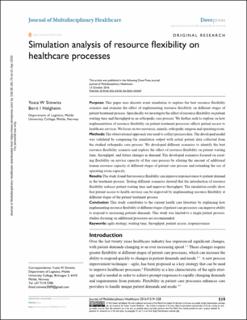| dc.contributor.author | Simwita, Yusta Wilson | |
| dc.contributor.author | Helgheim, Berit Irene | |
| dc.date.accessioned | 2023-02-21T16:59:17Z | |
| dc.date.available | 2023-02-21T16:59:17Z | |
| dc.date.created | 2016-11-10T12:25:27Z | |
| dc.date.issued | 2016 | |
| dc.identifier.citation | Journal of Multidisciplinary Healthcare. 2016, 9, 519-528. | en_US |
| dc.identifier.issn | 1178-2390 | |
| dc.identifier.uri | https://hdl.handle.net/11250/3052902 | |
| dc.description.abstract | Purpose: This paper uses discrete event simulation to explore the best resource flexibility scenario and examine the effect of implementing resource flexibility on different stages of patient treatment process. Specifically we investigate the effect of resource flexibility on patient waiting time and throughput in an orthopedic care process. We further seek to explore on how implementation of resource flexibility on patient treatment processes affects patient access to healthcare services. We focus on two resources, namely, orthopedic surgeon and operating room. Methods: The observational approach was used to collect process data. The developed model was validated by comparing the simulation output with actual patient data collected from the studied orthopedic care process. We developed different scenarios to identify the best resource flexibility scenario and explore the effect of resource flexibility on patient waiting time, throughput, and future changes in demand. The developed scenarios focused on creating flexibility on service capacity of this care process by altering the amount of additional human resource capacity at different stages of patient care process and extending the use of operating room capacity. Results: The study found that resource flexibility can improve responsiveness to patient demand in the treatment process. Testing different scenarios showed that the introduction of resource flexibility reduces patient waiting time and improves throughput. The simulation results show that patient access to health services can be improved by implementing resource flexibility at different stages of the patient treatment process. Conclusion: This study contributes to the current health care literature by explaining how implementing resource flexibility at different stages of patient care processes can improve ability to respond to increasing patients demands. This study was limited to a single patient process; studies focusing on additional processes are recommended. Keywords: agile strategy, waiting time, throughput, patient access, responsiveness | en_US |
| dc.language.iso | eng | en_US |
| dc.rights | Navngivelse 4.0 Internasjonal | * |
| dc.rights.uri | http://creativecommons.org/licenses/by/4.0/deed.no | * |
| dc.title | Simulation analysis of resource flexibility on healthcare processes | en_US |
| dc.type | Peer reviewed | en_US |
| dc.type | Journal article | en_US |
| dc.description.version | publishedVersion | en_US |
| dc.source.pagenumber | 519-528 | en_US |
| dc.source.volume | 9 | en_US |
| dc.source.journal | Journal of Multidisciplinary Healthcare | en_US |
| dc.identifier.doi | 10.2147/JMDH.S112713 | |
| dc.identifier.cristin | 1399096 | |
| cristin.ispublished | true | |
| cristin.fulltext | original | |
| cristin.qualitycode | 1 | |

